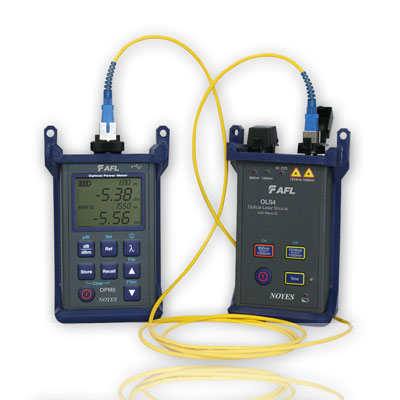The Duty of Optical Fiber Screening in Ensuring Top Quality and Efficiency in Connectivity Solutions
In today's quickly evolving digital landscape, the value of optical fiber testing can not be overstated, as it offers as a foundation for ensuring the top quality and performance of connection services. As innovation continues to advance, the future of optical fibre testing positions fascinating obstacles and opportunities that merit closer assessment.
Value of Optical Fibre Screening
The relevance of optical fiber testing can not be overstated in making sure the stability and efficiency of interaction networks. As the foundation of contemporary telecommunications, optical fibers promote high-speed data transmission, making their reliability important to operational success. Testing functions as a positive action to identify prospective concerns such as signal loss, depletion, and physical damages, which can compromise network performance.
Normal testing enables the verification of installation top quality and the detection of defects that might impact information integrity - optical fibre diameter analyser. By utilizing strenuous testing protocols, network operators can alleviate the threats connected with network failings, consisting of downtime and monetary losses. Furthermore, optical fiber testing makes sure conformity with sector standards and guidelines, enhancing the overall high quality of service supplied to end-users.
Ultimately, the organized analysis of optical fibers adds to the long life and effectiveness of interaction systems. It makes it possible for stakeholders to make educated decisions concerning maintenance, upgrades, and troubleshooting. In a landscape where information is progressively important, focusing on optical fibre screening is vital to sustaining robust and efficient connectivity services, thus supporting the needs of contemporary digital environments.
Types of Optical Fibre Tests
Numerous testing approaches are utilized to make certain the performance and integrity of optical fibres within communication networks. These examinations can be generally classified into two primary types: setup examinations and upkeep tests.
Installment examinations are performed immediately after the installation of optical fibre cords to validate their efficiency and stability - robotic vision. One of the most typical installment tests include Optical Time-Domain Reflectometry (OTDR) examinations, which analyze the high quality of the fibre by determining mistakes or breaks, and end-to-end loss examinations, which gauge the total optical loss from one end of the fiber to the other
Upkeep examinations, on the other hand, are carried out regularly to guarantee ongoing efficiency and spot prospective issues with time. These consist of aesthetic assessment, which checks for physical problems or incorrect installations, and connection examinations, which confirm that the signal can pass through the fibre without interruption.
In addition, advanced examinations such as Polarization Setting Diffusion (PMD) and Chromatic Diffusion (CD) tests can be carried out to examine the fibre's efficiency under numerous conditions. By utilizing these diverse testing techniques, specialists can preserve high criteria of top quality and integrity in optical fibre networks.
Advantages of Routine Testing
Regular screening of optical fibers this content plays an essential function in preserving the general efficiency and integrity of communication networks. By carrying out routine assessments, organizations can make certain that their fiber optic installations meet sector requirements and operate successfully. This proactive technique aids to determine prospective weaknesses and destruction with time, enabling for prompt interventions before concerns escalate.

Cost-effectiveness is one more advantage. By dealing with minor problems early, companies can avoid the high costs related to significant repair work or system failings. Regular screening likewise cultivates compliance with regulative demands, making sure that the network complies with essential safety and efficiency criteria.
Typical Concerns Identified
Recognizing typical concerns in optical fiber networks is necessary for maintaining optimum performance and reliability. Different factors can contribute to interruptions, consisting of physical damages, poor installment practices, and ecological influences.
Physical damages, such as bends, over at this website breaks, or abrasions, can dramatically break down signal top quality. Inappropriate installation methods, including extreme stress or inadequate protecting of cords, might result in boosted depletion and loss of connectivity. Additionally, ecological variables such as temperature level fluctuations, moisture access, and rodent interference can endanger the integrity of the fibre.
Port issues likewise frequently emerge, with inappropriate alignment or contamination resulting in boosted insertion loss. Splicing errors can present considerable signal deterioration if not carried out with precision.

Dealing with these typical issues via normal optical fibre testing not only enhances network reliability however additionally optimizes overall performance, ensuring that connectivity remedies continue to be robust and efficient.
Future Trends in Checking
As the need for high-speed connectivity proceeds to increase, the future of optical fiber screening will progressively focus on automation and advanced analytics. The integration of expert system (AI) and maker understanding (ML) in screening processes will certainly allow more reliable information evaluation and anticipating maintenance, minimizing downtime and improving general network reliability. Automated testing options will enhance the inspection and qualification of fiber networks, lessening human error and raising testing content throughput.
One more substantial fad is the fostering of remote screening technologies. As the implementation of fiber networks increases into remote and underserved locations, remote testing capacities will certainly allow professionals to keep track of and identify network conditions without physical visibility, therefore reducing functional prices and enhancing feedback times.
Additionally, there will certainly be a change towards more extensive testing requirements that incorporate not just typical loss measurements but likewise performance metrics such as latency and data transfer use. This alternative method will facilitate better network management and optimization techniques.
As these patterns evolve, the optical fibre screening landscape will not only boost the quality and efficiency of connection remedies yet also support the expanding complexities of contemporary interaction networks.
Conclusion
To conclude, optical fibre screening offers as a basic component in keeping the honesty and effectiveness of interaction networks. By systematically examining numerous specifications through established screening techniques, possible problems are recognized and fixed, making certain ideal efficiency. The ongoing dedication to regular screening not just boosts information transmission but additionally lines up with sector requirements, promoting reliability in network facilities. As innovation evolves, the importance of cutting-edge testing techniques will certainly proceed to grow, further progressing connection options.